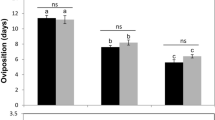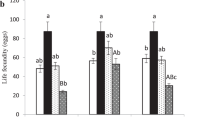Abstract
To understand the influence of temperature on host–parasitoid interactions as a consequence of climatic change, we studied development, survival, and fecundity of field and laboratory strains of the Helicoverpa armigera larval endoparasitoid, Campoletis chlorideae at five different temperatures under laboratory conditions. Post-embryonic development period and degree-days required for completing the life cycle by both the strains decreased by 2.5 and 1.5 folds at 27°C compared to 18°C. Post embryonic development period showed a negative (r = −0.99, P < 0.001) and the development rate a positive (r = 0.99, P < 0.001) association with an increase in temperature. However, no parasitoid larvae survived in H. armigera larvae reared at 12 and 35°C after parasitization, suggesting that temperatures ≥35°C as a result of global warming will be lethal for development and survival of immature stages of C. chlorideae. Adult longevity was negatively associated (r = −0.91 to −0.96, P < 0.001) with temperatures between 12 and 35°C. The parasitoid adults stored at 12°C survived for longer period and exhibited higher fecundity than those kept at 27°C, but the efficiency of parasitism and adult emergence were quite low. Sex ratio of the progeny at 12°C was highly male-biased than the insects kept at 27°C. Laboratory strain of the parasitoid exhibited better survival, and the adults lived longer than the field strain at 18°C than at 27°C. Therefore, C. chlorideae adults stored at 18°C could be used for parasitism, while the immature stages should be reared at 27°C for mass production of the parasitoid for biological control of H. armigera.


Similar content being viewed by others
References
Ables JR, Shepard M, Holman JR (1976) Development of the parasitoids Spalangia endius and Muscidifurax raptor in relation to constant and variable temperature: simulation and validation. Environ Entomol 5:329–332
Bernal JS (1995) An ecological basis for the field performances of two exotic parasites (Hymenoptera: Aphidiidae et Aphelinidae) of the Russian wheat aphid (Diuraphis noxia Mordwilko, Homoptera: Aphididae). PhD thesis, University of California, Riverside, USA
Bhatnagar VS, Lateef SS, Sithanantham S, Pawar CS, Reed W, (1982) Research on Heliothis at ICRISAT. In: Reed W and Kumble V (eds) Proceedings of the International Workshop on Heliothis Management, 15–20 November 1981. International Crops Research Institute for the Semi-Arid Tropics, Patancheru, Andhra Pradesh, India. pp 385–395
Butler GD Jr, Lopez JD (1980) Trichogramma pretiosum: development in two hosts in relation to constant and fluctuating temperatures. Ann Entomol Soc America 73:671–673
Cave RD, Gaylor MJ (1988) Influence of temperature and humidity on development and survival of Telenomus reynoldsi parasitizing Geocoris punctipes eggs. Ann Entomol Soc America 81:278–285
Chihrane J, Laugé G, Hawlitzky N (1993) Effects of high temperature shocks on the development and biology of Trichogramma brassicae (Hym.: Trichogrammatidae). Entomophaga 38:185–192
Cook DF (2007) Influence of temperature on copula duration and mating propensity in Lucilia cuprina Wiedemann (Diptera: Calliphoridae). Australian J Entomol 33:5–8
Dhillon MK, Sharma HC (2007a) Survival and development of Campoletis chlorideae on various insect and crop hosts: Implications for Bt-transgenic crops. J Appl Entomol 131:179–185
Dhillon MK, Sharma HC (2007b) Effect of storage duration and temperature on viability of eggs of Helicoverpa armigera (Lepidoptera: Noctuidae). Bull Entomol Res 97:55–59
Dowell RV (1979) Synchrony and impact of Amitus hesperidum on its host, Aleurocanthus woglumi in southern Florida. Entomophaga 24:221–227
GenStat (2008) Introduction to GenStat for Windows®. Genstat, 10th edn. Lawes Agricultural Trust, Rothamsted Experimental Station
Henneberry TJ, Clayton TE (1991) Tobacco budworm (Lepidoptera: Noctuidae): temperature effects on mating, ovipositon, egg viability, and moth longevity. J Econ Entomol 84:1242–1246
Hoelscher CE, Vinson SB (1971) The sex ratio of hymenopteran parasitoid, Campoletis predistinctus, is affected by photoperiod, mating and temperature. Ann Entomol Soc America 64:1373–1376
Jallow MFA, Matsumura M (2001) Influence of temperature on the rate of development of Helicoverpa armigera (Hübner) (Lepidoptera: Noctuidae). Appl Entomol Zool 36:427–430
Kalaitzaki AP, Lykouressis DP, Perdikis ChD, Alexandrakis VZ (2007) Effect of temperature on development and survival of the parasitoid Pnigalio pectinicornis (Hymenoptera: Eulophidae) reared on Phyllocnistis citrella (Lepidoptera: Gracillariidae). Environ Entomol 36:497–505
King BH (1987) Offspring sex ratios in parasitoid wasps. Q Rev Biol 62:367–395
King BH (1996) Sex ratio responses to other parasitoid wasps: multiple adaptive explanations. Behav Ecol Sociobiol 39:367–374
Maceda A, Hohmann CL, dos Santos HR (2003) Temperature effects on Trichogramma pretiosum Riley and Trichogrammatoidea annulata De Santis. Brazilian Arch Biol Tech 46:1–11
McClure MS (1978) Seasonal development of Fiorinia externa, Tsugaspidiotus tsugae (Homoptera: Diaspididae), and their parasite, Aspidiotiphagus citrinus (Hymenoptera: Aphelinidae): importance of parasite-host synchronism to the population dynamics of two scale pests of hemlock. Environ Entomol 7:863–870
Miller JC (1996) Temperature-dependent development of Meteorus communis (Hymenoptera: Braconidae), a parasitoid of the variegated cutworm (Lepidoptera: Noctuidae). J Econ Entomol 89:877–880
Miller JC, Gerth W (1994) Temperature-dependent development of Aphidius matricariae as a parasitoid of the Russian wheat aphid. Environ Entomol 23:1304–1307
Nandihalli BS (1994) Ecology of an egg parasitoid Trichogramma chilonis Ishii and a larval parasitoid Campoletis chlorideae Uchida, of the oriental bud worm, Helicoverpa assulta (Guenee). PhD thesis, Seoul National University, Seoul, Korea
Pandey AK, Tripathi CPM (2008) Effect of temperature on the development, fecundity, progeny sex ratio and life-table of Campoletis chlorideae, an endolarval parasitoid of the pod borer, Helicoverpa armigera. BioControl 53:461–471
Pawar CS, Bhatnagar S, Jadhav DR (1989) Campoletis chlorideae Uchida (Hymenoptera: Ichneumonidae) as a parasite of Helicoverpa armigera (Hub.) (Lepidoptera: Noctuidae) in southwest India. Proc Indian Acad Sci (Animal Sci) 95:695–703
Qiu BL, De Barro PJ, Ren SX, Xu CX (2007) Effect of temperature on the life history of Eretmocerus sp nr. furuhashii, a parasitoid of Bemisia tabaci. BioControl 52:733–746
Raju GT, Biradar AP, Balikai RA, Rao KJ (2001) Effect of temperature, relative humidity and their interactions on the development of Campoletis chlorideae Uchida. Adv Agril Res, India 16:49–53
Romeis J, Shanower TG (1996) Arthropod natural enemies of Helicoverpa armigera (Hubner) (Lepidoptera: Noctuidae) in India. Biocontr Sci Tech 6:481–508
Sharma HC, Dhillon MK, Arora R (2008) Effects of Bacillus thuringiensis δ-endotoxin-fed Helicoverpa armigera on the survival and development of the parasitoid Campoletis chlorideae. Entomol Exp Appl 126:1–8
Sinclair BJ, Vernon P, Klok CJ, Chown SL (2003) Insects at low temperatures: an ecological perspective. Trends Ecol Evol 18:257–262
Teggelli RG, Rao KJ, Kulkarni KA (2004) Effect of temperature and relative humidity and their interactions on the development of Campoletis chlorideae Uchida. Karnataka J Agril Sci 17:476–478
Tikar SN, Rao NGV, Satpute NS, Dandale HG (2001) Egg laying preference and larval parasitization of Helicoverpa armigera (Hubner) on weed host Lagascea mollis (Cav) in comparison with cotton at Akola. Insect Environ 6:180–181
Wilson LT, Barnett WW (1983) Degree-days: an aid in crop and pest management. California Agric (USA) 37:4–7
Acknowledgments
The technical support of Messrs V. Venkateshwara Rao and S. V. N. Chandra and funding by the Indo-Swiss Collaboration on Biotechnology (ISCB), Swiss Agency for Development and Cooperation (SDC), Berne, Switzerland, and the Department of Biotechnology (DBT), New Delhi, India, are gratefully acknowledged.
Author information
Authors and Affiliations
Corresponding author
Additional information
Handling Editor: Torsten Meiners.
Rights and permissions
About this article
Cite this article
Dhillon, M.K., Sharma, H.C. Temperature influences the performance and effectiveness of field and laboratory strains of the ichneumonid parasitoid, Campoletis chlorideae . BioControl 54, 743–750 (2009). https://doi.org/10.1007/s10526-009-9225-x
Received:
Accepted:
Published:
Issue Date:
DOI: https://doi.org/10.1007/s10526-009-9225-x




